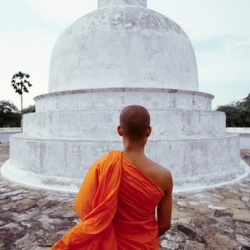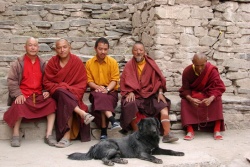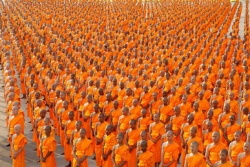Rūpa
In Hinduism and Buddhism, rūpa (Devanagari: रूप; Thai: รูป) generally refers to material objects, particularly in regards to their appearance.
Definition
According to the Monier-Williams Dictionary (2006), rūpa is defined as:
- ... any outward appearance or Phenomenon or colour (often pl.) , Form , shape
- to assume a Form ; often ifc. = " having the Form or appearance or colour of " , " formed or composed of " , " consisting of " , " like to " ....
Buddhism
In general, rūpa is the Buddhist concept of material Form, including both the Body and external matter.
More specifically, in the Pali Canon, rūpa is contextualized in three significant frameworks:
- rūpa-Khandha – "material forms," one of The five aggregates (Khandha) by which all Phenomena can be categorized .
- rūpa-āyatana – "visible objects," the external sense objects of the Eye, one of the six external sense bases (āyatana) by which the World is known
- Nāma-rūpa – "name and Form" or "Mind and Body," which in the causal chain of Dependent origination (paticca-samuppāda) arises from Consciousness and leads to the arising of the sense bases.
In addition, more generally, rūpa is used to describe a statue, in which it is sometimes called Buddharupa.
Rūpa-Khandha
Rūpa is not matter as in the metaphysical substance of materialism. Instead it means means both materiality and sensibility — signifying, for example, a tactile object both insofar as that object is made of matter and that the object can be tactilely sensed. In fact rūpa is more essentially defined by its amenability to being sensed than its being matter: just like everything else it is defined in terms of its function; what it does, not what it is. As matter, rūpa is traditionally analysed in two ways: as four primary elements (Pali, Mahābhūta); and, as ten or twenty-four secondary or derived elements.
Four primary elements
Existing rūpa consists in the four primary or underived (no-upādā) elements:
Derived matter
In The Abhidhamma Pitaka and later Pali literature, rūpa is further analyzed in terms of ten or twenty-three or twenty-four types of secondary or derived (upādā) matter. In the list of ten types of secondary matter, the following are identified:
If twenty-four secondary types are enumerated, then the following fifteen are added to the first nine of the above ten:
- femininity
- Masculinity or virility
- Life or vitality
- Heart or Heart-basis
- physical indications (movements that indicate intentions)
- vocal indications
- space element
- physical lightness or buoyancy
- physical yieldingness or plasticity
- physical handiness or wieldiness
- physical grouping or integration
- physical extension or maintenance
- physical aging or decay
- physical Impermanence
- Food
A list of 23 derived types can be found, for instance, in The Abhidhamma Pitaka's Dhammasangani (e.g., Dhs. 596), which omits the list of 24 derived types' "Heart-basis."
In the Kevaddhasutta (Dīgha i,11 <D.i,223>), it is said that the question 'Where do the four mahābhūtā finally cease?' is wrongly asked, and that the question should be 'Where do [the four mahābhūtā get no footing? Where do nāma and rūpa finally cease?'
Matter or substance (rūpa) is essentially inertia or resistance (see Dīgha ii,2 <D.ii,62>[9]), or as the four mahābhūtā it can be regarded as four kinds of behaviour (i.e. the four primary patterns of inertia—see NĀMA).
Behaviour (or inertia) is independent of the particular sense-experience that happens to be exhibiting it: a message in the Morse code (which would be a certain complex mode of behaviour) could be received in any sense-experience (though seeing and hearing are the most usual).
In any one kind of sense-experience there is revealed a vast set of various behaviours, of various patterns of inertia; and in any other contemporary sense-experience there is revealed a set that, to a great extent, corresponds to this first set.
[a] (One particular group of behaviours common to all my sense-experiences is of especial significance—it is 'this body', ayam kāyo rūpī catummahābhūtiko ('this body composed of matter, of the four great entities') [[[Majjhim]]a viii,5 <M.i,500>].)
Thus, when I see a bird opening its beak at intervals I can often at the same time hear a corresponding sound, and I say that it is the (visible) bird that is (audibly) singing.
The fact that there seems to be one single (though elaborate) set of behaviours common to all my sense-experiences at any one time, and not an entirely different set for each sense, gives rise to the notion of one single material world revealed indifferently by any one of my senses.
Furthermore, the material world of one individual largely corresponds to that of another (particularly if allowance is made for difference in point of view), and we arrive at the wider notion of one general material world common to all individuals.
[b] The fact that a given mode of behaviour can be common to sense-experiences of two or more different kinds shows that it is independent of any one particular kind of consciousness (unlike a given perception—blue, for example, which is dependent upon eye-consciousness and not upon ear-consciousness or the others);
and being independent of any one particular kind of consciousness it is independent of all consciousness except for its presence or existence.
One mode of behaviour can be distinguished from another, and in order that this can be done they must exist—they must be present either in reality or in imagination, they must be cognized.
But since it makes no difference in what form they are present—whether as sights or sounds (and even with one as visible and one as audible, and one real and one imaginary)—, the difference between them is not a matter of consciousness.
[c] Behaviour, then, in itself does not involve consciousness (as perception does), and the rūpakkhandha is not phassapaccayā (as the saññākkhandha is)—see Majjhima xi,9 <M.iii,17>.
In itself, purely as inertia or behaviour, matter cannot be said to exist. (Cf. Heidegger, op. cit., p. 212.)
And if it cannot be said to exist it cannot be said to cease. Thus the question 'Where do the four mahābhūtā finally cease?' is improper.
(The question will have been asked with the notion in mind of an existing general material world common to all. Such a general world could only exist—and cease—if there were a general consciousness common to all.
But this is a contradiction, since consciousness and individuality ;see SAKKĀYA are one.) But behaviour can get a footing in existence by being present in some form.
As rūpa in nāmarūpa, the four mahābhūtā get a borrowed existence as the behaviour of appearance (just as feeling, perception, and intentions, get a borrowed substance as the appearance of behaviour).
And nāmarūpa is the condition for viññāna as viññāna is for nāmarūpa. When viññāna (q.v.) is anidassana it is said to have ceased (since avijjā has ceased).
Thus, with cessation of viññāna there is cessation of nāmarūpa, and the four mahābhūtā no longer get a footing in existence.
(The passage at Salāyatana Samyutta xix,8 <S.iv,192>, ...bhikkhu catunnam mahābhūtānam samudayañ ca atthagamañ ca yathābhūtam pajānāti, ('...a monk understands as they really are the arising and ceasing of the four great entities') is to be understood in this sense.)
From the foregoing discussion it can be seen that in order to distinguish rūpa from nāma it is only necessary to separate what is (or could be) common to two or more kinds of consciousness from what is not.
But care is needed. It might seem that shape is rūpa and not nāma since it is present in both eye-consciousness and body-consciousness (e.g. touching with the fingers). This, however, is a mistake.
Vision is a double faculty: it cognizes both colour and shape (see FUNDAMENTAL STRUCTURE §§I/4 & II/8).
The eye touches what it sees (it is only necessary to run the eye first across and then down some vertical lines or bars to discover this), and the result is coloured shapes.
The eye is capable of intentional movement more delicate even than the fingers, and the corresponding perception of shapes is even more subtle.
[d] Similar considerations apply, though in a much lesser degree, to hearing (and even to taste and to smell) where perception of shape, when present (however vaguely), corresponds to movement, real or imaginary (which will include the directional effect of two ears), of the head or of the entire body.
[e] But provided different kinds of consciousness are adequately distinguished, this method gives a definite criterion for telling what is matter from what is not.
It is consequently not necessary to look for strict analysis of the four mahābhūtā: provided only that our idea of them conforms to this criterion, and that they cover all the primary modes of matter, this is all that is needed.
Thus it is not necessary to look beyond the passage at Majjhima xiv,10 <M.iii,240> for a definition of them.
(It is easy, but fatal, to assume that the Buddha's Teaching is concerned with analysis for its own sake, and then to complain that the analysis is not pushed far enough.)
A human body in action, clearly enough, will present a behaviour that is a highly complex combination of these primary modes: it is behaviour of behaviour, but it still does not get beyond behaviour.
(It is important to note that the laws of science—of biochemistry and physics in particular—do not cover behaviour (i.e. matter) associated with conscious [intentiona action]].)
Footnotes:
[a] Mind-experience is not considered in this Note to avoid complication. It is not, however, essentially different. See MANO [c].
[b] Natural science, in taking this concept as its starting-point and polishing it a little to remove irregularities, has no place for the individual and his sense-experience (let alone mind-experience or imagination);
for the material world of science is by definition utterly without point of view (in relativity theory every point is a point of view, which comes to the same thing), it is uniformly and quite indifferently communal—it is essentially public.
Consciousness, intention, perception, and feeling, not being public, are not a part of the universe of science.
Science is inherently incapable of understanding the nature of material change due to conscious action—which is, concisely, reflexive exercise of preference for one available mode of behaviour (or set of them) at the expense of the others.
(Quantum physics, in hoping to reinstate the 'observer'—even if only as a point of view—, is merely locking the stable door after the horse has been stolen.)
[c] A visual and an auditive experience differ in consciousness (whether or not they differ in matter); but between two different visual (or auditive) experiences the difference is in matter (or substance, or inertia) and not in consciousness.
[At this point the question might be asked, 'What is the material difference between the simple experiences of, for example, a blue thing and a red thing (ignoring spatial extension)?'
The immediate answer is that they are simply different things, i.e. different inertias.
But if it is insisted that one inertia can only differ from another in behaviour (i.e. in pattern of inertia)—in other words, that no inertia is absolutely simple—, we shall perhaps find the answer in the idea of a difference in frequency.
But this would involve us in discussion of an order of structure underlying the four mahābhūtā.
See FUNDAMENTAL STRUCTURE [j].]
Thus it will be observed that all difference in appearance (nāma) is difference in either consciousness (viññāna) or matter (rūpa).
Why is this?
Neither consciousness nor matter, by itself, can appear (or be manifest); for consciousness by itself lacks substance or specification—it is pure presence or existence without any thing that is present (or exists)—,
and matter by itself lacks presence or existence—it is pure substance or specification, of which one cannot say 'it is' (i.e. 'it is present [or absent]').
Appearance or manifestation must necessarily partake of both consciousness and matter, but as an overlapping () and not simply an addition (for the simple superposition of two things each itself incapable of appearing would not produce appearance).
Appearance is existence as substance, or substance as existence, and there must be also simple existence (or consciousness) and simple substance (or matter) to support this imbrication.
Appearance, in a manner of speaking, is sandwiched between consciousness and matter: there must be rūpa, and nāma, and viññāna ().
(There is more to be said about this, but not briefly.) It is because of this structure that all differences in appearance can be resolved into differences either of consciousness or of matter (or both).
[d] Strictly, the shapes are there before the eyeball is moved, just as the hand perceives the shape of an object merely by resting on it; movement of the eyeball, as of the fingers, only confirms the perception and makes it explicit.
This does not matter: we are concerned only to point out the similarity of the eye and the hand as both yielding perceptions of shape, not to give an account of such perceptions.
[e] This discussion, it will be seen, makes space a secondary and not a primary quality (see NĀMA [d]):
space is essentially tactile (in a wide sense), and is related to the body (as organ of touch) as colours and sounds (and so on) are related to the eye and the ear—indeed, we should do better to think of 'spaces' rather than of any absolute 'space'.
Space, in fact, has no right to its privileged position opposite time as one of the joint basic determinants of matter: we are no more entitled to speak of 'space-(&-)time' than we are of 'smell-(&-)time'.
Time itself is not absolute (see PATICCASAMUPPĀDA [c] & FUNDAMENTAL STRUCTURE §II/5), and material things, as they exist, are not 'in' time (like floatage on a river), but rather have time as their characteristic; space, however, besides not being absolute, is not, strictly, even a characteristic of matter.
On the other hand, our first four sense-organs are each a part of the body, which is the fifth, and space does hold a privileged position relative to colour, sound, smell, and taste.
Thus we sometimes find in the Suttas (e.g. Majjhima vii,2 <M.i,423>) an ākāsadhātu alongside the four mahābhūtā; and for practical purposes—which is ultimately all we are concerned with—space can be regarded as a quasi-material element.
But the Milindapañha has no business whatever to put ākāsa together with nibbāna as asankhata.
[f] Pace Russell: 'Physical things are those series of appearances whose matter obeys the laws of physics'. Op. cit., VIIIth Essay, §xi.


